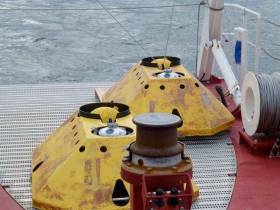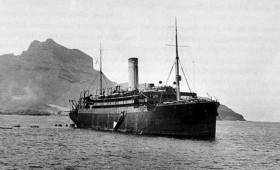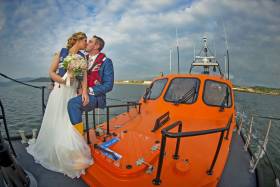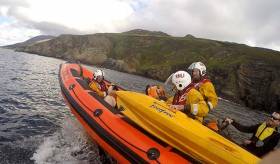Displaying items by tag: Lough Swilly
Donegal Lifeboat Volunteers Make Final Preparations for ‘Mayday Mile’ Challenge on Errigal
Final preparations are under way at the three Donegal-based RNLI lifeboat stations at Bundoran and Lough Swilly and Arranmore for the charity’s Mayday Mile challenge which will see six volunteer crew — two from each station — climb Donegal’s highest summit, Errigal, this Saturday 13 May in full RNLI crew kit.
Since the fundraiser was announced a few weeks ago, the six lifeboat crew members — Chris Fox and Brian Fowley (Bundoran), Stephen Quigley and Barry Nixon (Lough Swilly) and Aisling Cox and Brian Proctor (Arranmore) — have been psyching themselves up for the challenge. Gym sessions have been completed and many steps have been climbed in preparation for the event.
Killian O’Kelly, RNLI water safety education manager and organiser of the fundraiser has been encouraging the six crew as they ready for the challenge.
“We’ll be right there with them on the day — we know it’ll be a tough one for them,” he said. “I’d like to thank everyone who has donated so far and remind people who would like to contribute that the JustGiving page remains open and details can be found on each station’s Facebook page.
“A massive thanks also to the crew from each station who have volunteered to complete the challenge. It’s not what the crews are used to, they face challenging conditions at sea when they go and help those in trouble on the water, but this is very different for them. We also want to show people where their funds go and that we are grateful for every cent to give us.”
During the month of May the RNLI is encouraging members of the public to complete their own ‘Mayday Mile’ however they see fit. The money raised could help RNLI lifesavers have everything they need to keep families safe this summer. Warmer weather draws more people to the water and RNLI volunteer lifeboat crews will drop whatever they’re doing when a call for help comes in.
For updates on the Errigal climb on the day, keep an eye on the social media channels of Arranmore RNLI, Bundoran RNLI and Lough Swilly RNLI.
Donations to the Errigal challenge can be made via the JustGiving page and the final sum will be divided equally between the three Donegal stations.
Elsewhere, volunteers with Dunmore East RNLI are preparing for their own vertical Mayday Mile by summiting the highest peaks in both the Comeragh and Knockmealdown mountains, as previously reported on Afloat.ie.
Donegal Lifeboat Crews Aim to Complete ‘Mayday Mile’ on Errigal
Volunteers from the three Donegal-based RNLI lifeboat stations at Bundoran, Lough Swilly and Arranmore will climb the highest mountain in the county, Errigal, as part of the charity’s Mayday fundraising campaign.
Six crew — two from each station — will ascend the 751 metres of the Donegal mountain in full lifeboat gear on Saturday 13 May in a combined fundraising effort for the three stations.
The idea for the challenge came about after three members of the Bundoran crew walked the Bundoran 10-mile event last year in their full kit, raising over €6,000 for the charity.
This year they wanted to do something different, while involving their fellow lifeboat crew mates from Lough Swilly and Arranmore.
 Barry Nixon and Stephen Quigley of Lough Swilly RNLI | Credit: RNLI/Lough Swilly
Barry Nixon and Stephen Quigley of Lough Swilly RNLI | Credit: RNLI/Lough Swilly
Aisling Cox and Brian Proctor from Arranmore RNLI, Chris Fox and Brian Fowley from Bundoran RNLI and Stephen Quigley and Barry Nixon from Lough Swilly RNLI have all volunteered to complete the climb on 13 May.
Chris Fox was one of those who took part in last year’s Bundoran 10-mile event. He said: “While the blisters didn’t settle for a few days, it was still a great experience and a really great fundraising event for Bundoran lifeboat station.
“We wanted to change it up this year and put the challenge out to our two other stations in Donegal to see if they would help us complete the Mayday Mile on Errigal.”
Stephen Quigley added: “We jumped at the chance for this challenge with our fellow crew members from around the county. There is nowhere more iconic in Donegal than Errigal; walking up it in full kit will be quite the challenge. But it will be a great to come together as one crew with this fundraiser for the three stations here in Donegal: Bundoran, Lough Swilly and Arranmore.”
 Brian Proctor and Aisling Cox of Arranmore RNLI | Credit: RNLI/John McCafferty
Brian Proctor and Aisling Cox of Arranmore RNLI | Credit: RNLI/John McCafferty
Aisling Cox is hopeful that the climb will help to raise the funds needed to keep all three stations running. “Mayday is our own call for help, as we rely on the generosity of the public to take part in events like the Mayday Mile and raise the funds that allow us to be there when we’re needed most,” she said.
“But we need to be ready. Training, kit, stations and fuel — these are just some of the things we need to save lives and that people fundraising can help provide.”
With the three stations in Co Donegal expected to be busy this summer, the RNLI is asking people to support the Mayday Mile throughout the month of May by covering the distance in any way they choose and raising vital funds to keep people safe.
Donations to the Errigal challenge can be made via the JustGiving page and the final sum will be divided equally between the three Donegal stations.
Lough Swilly RNLI in County Donegal was tasked by the Irish Coast Guard at 2.26 pm Sunday 25th April to reports of a distress signal sighted around the Leenan Head area of the Lough.
After a short search, it was found to be a helium balloon shining in the sun and the crew was stood down. The Ops team would like to thank the members of the public that rang the Coast Guard, this could have easily been something more serious.
At 8.09 pm both boats were tasked to an incident off Leenan Pier. While both boats were en route, the Shannon class all-weather lifeboat was further tasked to reports of a boat aground on Inishtrahull.
A short time later both boats were stood down by the Irish Coast Guard and returned safely to Buncrana to be refuelled and made ready for service.
Remember if you need assistance in or on the water or see someone in trouble, dial 999 or 112 and ask for the Coast Guard.
Newest Naval Service Vessel, LÉ George Bernard Shaw Opens to Public in Lough Swilly
Newest Naval Service vessel, LÉ George Bernard Shaw is to open to the public for guided tours this weekend (7th-8th December) at Rathmullan Pier in Lough Swilly, Co. Donegal.
Navy personnel of the latest offshore patrol vessel (OPV90) P60 class will be on hand during the tours held on Saturday between 1300-1600 and the following Sunday 1400-1600.
The crew will also be looking forward to taking part in the PolarPlunge Charity Event in aid of Special Olympics Ireland.
As Afloat previously reported the €67m newbuild took part in PASSEX training exercises with a Belgian Navy frigate in the the Irish Sea prior to a visit to Dublin Port in October.
It is more than a year ago when the fourth and final P60 class made a delivery voyage to Cork Harbour from UK shipyard, Babcock Marine & Technology's facility located in Appledore.
The shipyard in north Devon has since closed though there have been attempts to reopen.
Acoustic Doppler Current Profilers Deployed In Lough Swilly
The Department of Transport, Tourism and Sport (DTTAS) advises that TechWorks Marine has deployed four trawl-resistant, bottom-mounted Acoustic Doppler Current Profilers (ADCPs) frames throughout Lough Swilly.
The frames deployed on Wednesday 20 February will be on the seafloor for a minimum period of one calendar month and a maximum period of two months (weather permitting).
Water sampling surveys are required to be carried out at the same time as the deployments and these are tide and weather dependent, and may cause a slight delay in recovery, hence the two-month deployment period.
The ADCPs will be measuring currents through the water column at each location over the month-long deployment. This data will be used to validate a hydrodynamic model of the area being developed for Irish Water.
The deployment locations as noted in Marine Notice No 5 of 2019 are (degrees, minutes, seconds) WGS84 as follows:
- ADCP 1: 55° 12' 59.5" N, 7° 34' 37.2" W
- ADCP 2: 55° 06' 51.9" N, 7° 29' 02.7" W
- ADCP 3: 55° 03' 52.4" N, 7° 32' 11.3" W
- ADCP 4: 55° 01' 17.5" N, 7° 32' 55.4" W
Each frame will have an ADCP sensor (for waves and currents), acoustic release, rigid recovery buoy, acoustic pinger and grapple line. The frames are approximately 1m2 and will remain on the seafloor for a period of up to 30 days, after which the frame will be retrieved by the acoustic release by the retrieval team of a pop-up buoy allowing for its recovery or by a grapple line recovery method.
During the extent of the deployment, ADCP frames 1, 2 and 3 will have a surface marker. The ADCP 1 and 2 will have a red in colour surface buoy and ADCP 3 will have a yellow in colour surface buoy. There will be no surface marker for ADCP 4 so vessel traffic will not need to avoid its location but should be aware of its presence.
Driver Three Times Over Legal Alcohol Limit In Buncrana Pier Tragedy, Inquest Hears
#Buncrana - An inquest into the Buncrana slipway tragedy of March 2016 has found that the driver of the car that slipped into Lough Swilly was more than three times over the drink-driving limit.
As previously reported on Afloat.ie, five people died after their car slipped into the water from a pier in Buncrana, Co Donegal on Sunday 20 March.
Sean McGrotty (49) was driving the car with his sons Mark (12) and Evan (8), his baby daughter Rioghnach-Ann, the children’s grandmother Ruth Daniels (59) and her daughter Jodi-Lee (14), according to The Irish Times.
Only Rioghnach-Ann was rescued from the car, thanks to the quick actions of local GAA player Davitt Walsh — who received a silver medal in the 2016 National Bravery Awards for his efforts.
Walsh told the inquest of his difficulties in getting back up the slipway from the water due to its coating of algae, noting that its slipperiness might not be obvious to people unfamiliar with the area.
Local man Francis Crawford also spoke at the inquest, recounting how he called to McGrotty has he saw the car slowly entering into the water at the bottom of the slipway, which was “slippery as ice” with algae.
“I was hoping that the emergency services would arrive and the car would not go down,” he said, adding that he believed it had been in the water for around 12 minutes before it sank.
McGrotty’s partner Louise James, who was away at the time of the incident, said through her solicitor: “I firmly believe the slipway should have been closed to the public or else proper warning signs displayed. It was an accident waiting to happen.”
The Irish Times has much more on the story HERE.
Mysteries of the S.S. Laurentic Revealed in Workshop
#Laurentic - History lovers on Thursday 6 April will get a closer view of some of the fascinating artefacts recovered from the tragic sinking of SS Laurentic in Lough Swilly as part of a unique workshop. The artefacts from the liner are to be held in the Tower Museum, Derry.
The workshop will give participants the chance to view a range of items recovered from the wreck site, some of which will be unveiled to the public for the first time.
Mayor of Derry City and Strabane, Alderman Hilary McClintock, said the workshops offered a unique experience for anyone who is interested in maritime history.
“In recent months following the Centenary of the sinking of the Laurentic we have become more aware of this significant chapter in our local story. There is currently a treasure trove of artefacts on display at the museum, and this is an exciting chance for anyone who wants to explore the story further to learn more about the archive.
“It’s fantastic that so many local people have contributed objects to the exhibition, which will reveal more about those who served on board on that fateful day, as well as the beautiful vessel itself.”
The event is part of the wider programme of activities surrounding the Laurentic exhibition, which is now in its third month at the museum and running until the end of June.
Education Officer with the Tower Museum, Ronan McConnell, said that participants will also have the opportunity to hear some of the unique stories behind the objects and their recovery.
“We are delighted to be unveiling a whole series of new objects not seen before which have been loaned to us recently, including some mystery objects which we are still trying to identify,” he revealed.
“We are very excited about sharing these objects with the public in the hope that they can help us to identify them. The generosity of local divers and history enthusiasts - including relatives of those who sailed on the Laurentic - has been absolutely fantastic and we are looking forward to revealing more about the artefacts during the workshop.
“The strengths of this exhibition lie in two major elements - the story and the artefacts. The sinking of the Laurentic off Lough Swilly, its connection with this city and the search for the gold which still lies at the bottom of the lough, has great resonance among local people and indeed visitors to the city. The exhibition has proven extremely popular since it opened. Some of the artefacts loaned to the museum for the exhibition have incredible stories and this is a great opportunity to relate these stories to participants during the workshop.”
The workshop begins at 10am, admission is free and tea and coffee will be provided. If you would like to attend, please RSVP with [email protected] or phone 028 71 372411
Donegal Remembers The Laurentic 100 Years On
#Laurentic - Last Wednesday (25 January) saw Donegal commemorate the centenary of the sinking of the SS Laurentic off Lough Swilly by German mines during the First World War.
Just 121 of the 475 people on board survived the tragedy, as TheJournal.ie reports — the second to befall the White Star Line that decade after the Titanic in 1912.
Descendants of those who lost their lives at sea that day in 1917 paid tribute to their bravery in an incident that still holds some mystery, as a cache of gold ingots from the armed merchant ship is thought to still lie on the sea floor.
TheJournal.ie has much more on the story HERE.
Lough Swilly RNLI Groom’s Wedding Speech Interrupted By Lifeboat Launch
#RNLI - Buncrana man Francy Burns wed his sweetheart, Carndonagh woman Helen McFarland, last Saturday 8 October in a wedding attended by their family, friends and the volunteers with Lough Swilly RNLI.
But it wasn’t all plain sailing, as after the vows were exchanged and Francy took the microphone to make his wedding speech, the lifeboat pagers went off and the volunteer lifeboat crew jumped to their feet and raced out of the room to the callout.
The incident was a reminder to Helen of what she can expect married to a lifeboat volunteer.
However, as Francy was preparing to follow his lifeboat colleagues and head out the door to the callout, the coxswain assured him they had enough crew and he could stay where he was and enjoy the day.
The callout was to a vessel with one person on board which had lost engine power and had been drifting for three hours.
Lough Swilly RNLI launched their new Shannon-class lifeboat and brought the vessel to safety, with the lifeboat crew returning to the wedding reception some hours later.
As the wedding reception was held in the Gateway Hotel, Francy had the perfect view out the window down on the berth from where the lifeboat is launched.
“It was certainly a day of mixed emotions,” said Francy. “I married the most beautiful and amazing woman but when I saw the crew stand up to head out for the lifeboat shout during my speech my first thoughts were to follow them.
“You never know what you are launching to but thankfully it was fairly straightforward. Helen understands how I feel about the lifeboat and she is fully supportive. You never know, I might even persuade her to sign up too.”
Lough Swilly lifeboat volunteer crew member and press officer Joe Joyce added: “The launch sort of added to the whole day. You couldn’t have planned it better.
“Everyone with Lough Swilly RNLI wish Francy and Helen every happiness on their marriage and we will see Francy down at the station for our next shout.”
Lough Swilly RNLI lifeboat rescued a sheep this afternoon after it fell approximately 200 feet from a cliff in County Donegal.
The alarm was raised at 4.30pm today when three local fishermen spotted the animal stranded on a ledge in a ravine at Leenan Head with no means of escape.
The fishermen contacted Malin Head Coast Guard and Lough Swilly’s inshore Atlantic 85 lifeboat was requested to launch.
Weather conditions at the time were described as good with a flat calm sea.
Once on scene, the volunteer lifeboat crew were met by the fishermen who pointed to where the distressed sheep was located. A kayaker who had also arrived on scene, first paddled in close to the cliff in an attempt to encourage the animal back up the hill.
With this failing to work, the lifeboat crew and the kayaker proceeded to enter the water and make their way towards the sheep where they safely caught her and gently placed her in the kayak before transferring her into the lifeboat.
Once onboard the lifeboat, the sheep was comforted by the crew and safely brought back to more familiar surroundings on shore.
Speaking following the call out, Joe Joyce, Lough Swilly RNLI Volunteer Lifeboat Press Officer said: ‘We think the young sheep had fallen about 200 feet and with nowhere to go she was shaking from her ordeal by the time we took her onboard the lifeboat. The RNLI is often called upon to rescue animals and we are always happy to assist not only to bring them to safety but also to ensure the safety of pet owners or farmers who may risk their own life in attempting to bring their animal safely back to shore.’



































































